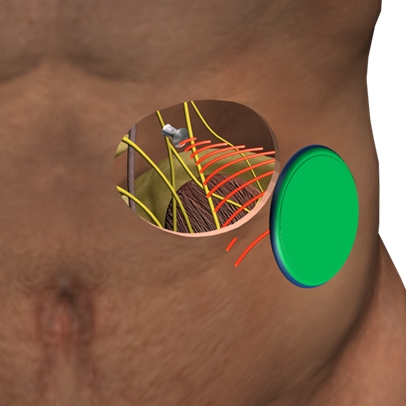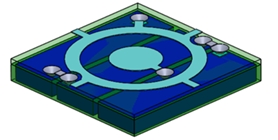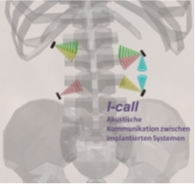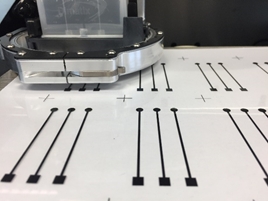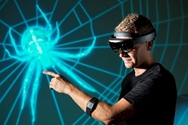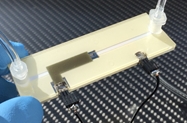Biomedical Microsystems
NeXT
Description: The aim of the project is to establish a tissue bank with genetically characterized tumors and to develop patient-related xenografts (PDXs) and organoids. The aim is to enable the rapid, specific and sensitive detection and characterization of pancreatic neuroendocrine tumors (PNET). This improved detection and characterization should increase the chance of surgical intervention and thus the survival rate of patients.
Contribution of IBMT: Within the project, the Fraunhofer IBMT has the following tasks: a) Molecular, genomic and transcriptomic characterization of PNET tumor organoids, PDX and CDX samples, PNET tissue and serum samples, b) Determination of PNET-specific CTC-related biomarkers for chip development, c) Establishment of a chip-based system for cell handling, positioning and enrichment as well as for cultivation and characterization under fluidic conditions.
Funding: BMBF, No. 01KT1910
Funding period: 09/2019-08/2022
VISION
Description: The aim of the project is to reduce the number of animal experiments by developing an analysis platform consisting of a combination of a fluidic organ culture system (in vitro) and in silico analysis of disease mechanisms. VISION develops and validates an in vitro / in silico analysis platform for inhalation toxicology studies, which will largely reduce and replace animal experiments in regulatory, application-oriented and basic research. At the same time, the microfluidic system opens up new possibilities for modelling disease processes in vitro and in silico. A disease model of COPD (chronic obstructive pulmonary disease) will be developed in close cooperation between biomedical technology, biological medical science and application-oriented SMEs, which combines different cell and tissue types in a physiologically relevant manner and permits detailed biological, pharmacological and toxicological analysis.
Contribution of IBMT: Within the project, the Fraunhofer IBMT has the following tasks: a) Implementation of an in vitro lung/liver model system to simulate the lung barrier and the metabolism process in the liver, b) investigation of human toxicological effects of pulmonary uptake of pollutants, c) analysis of transport and accumulation of pollutants using in vitro studies.
Funding: BMBF, No. 031L0153B
Funding period: 06/2019-05/2021
Magnetoceuticals
Description: The overall project goal is a novel electrostimulation system consisting of electronics worn externally on the body and a purely passive, highly miniaturized implant in the form of a biocompatible encapsulated magnetic body. The electronics worn on the body emit time-varying magnetic fields in the direction of the implant. They are concentrated by the implant and directed to the stimulation site. According to the Maxwell equations, the time-varying magnetic field results in a time-varying electric field, which, if all parameters are selected appropriately, is generated in the tissue to be stimulated and triggers an action potential there. The stimulation should be as effective and spatially resolved as is the case today with very complex implants.
Contribution of IBMT: The work of Fraunhofer IBMT focuses on the simulation of the overall system, the development of the implant bodies and the testing of the assembled systems.
Funding: BMBF 16ES0956
Funding period: 4/2019-03/2022
FlexiRet
Description: In the FlexiRet project we are developing a holistic concept for prosthetic vision up to a functional demonstrator. The concept is based on a minimally invasive approach, which allows the use also in patients with only partial loss of vision as well as the individual adaptation to the limitation of the individual patient. The implant consists of a mosaic-like array of thin silicon-based photodiodes with integrated thin-film stimulation electrodes combined with a foil substrate. The implant is surrounded by special thin implant encapsulation layers to protect the implant electronics from the humid environment in the eye.
Contribution of IBMT: The Fraunhofer IBMT designs the electrodes on the basis of computer simulations and develops the processes for combining the thinned photodiode array with a foil substrate.
Funding: BMBF 16ES0783
Funding period: 02/2018-01/2021
I-Call
Description: The project I-Call aims at the technical development and realization of a safe and secure signal transmission between implants based on ultrasound. So-called cMUTs (capacitive micromachined ultrasonic transducers), already known from ultrasound-based imaging, are used as ultrasonic transducers. In addition to tailor-made cMUTs for wireless communication, special ASICs for controlling the cMUTs and for processing the ultrasound signals, we develop communication protocols for communication via ultrasound. Although cMUTs made of silicon are biocompatible per se in contrast to established ultrasonic transducers and thus suitable for implantation, we aim at using them primarily in a hermetic metal housing (e.g. titanium). Project tasks also comprise the development of suitable housings and methods for sound coupling.
Contribution of IBMT: a) Simulation and realization of cMUTs in bulk micromachining and their characterization, b) development of implant electronics and firmware for controlling implant communication.
Funding: BMBF 16ES0752K
Funding period: 01/2018-12/2020
NanoEDGE
Description: NanoEDGE is an interdisciplinary research project aimed at combining production techniques for flexible electrodes with expertise in nanomaterial fabrication and characterization to further improve established diagnostic methods such as electroencephalography (EEG) and electromyography (EMG). The use of ultrathin electrodes without gel, which adapt exactly to the skin surface, should allow stable measurements over longer periods of time. We would like to achieve particularly good electrical contact with the skin with printed carbon nanoparticle electrodes.
Contribution of IBMT: The work of the Fraunhofer IBMT aims to develop an ink made of carbon nanoparticles for inkjet printing, a scalable printing process and a resource-efficient process chain for the production of electrodes for direct skin contact. The printed electrodes are to adapt exactly to the contour of the skin.
Funding: BMBF 02P17W000
Funding period: 01/2018-12/2020
Cryo-Automation
Description: This project deals with the investigation of approaches for the automation of handling processes in the cryopreservation and storage of biological samples. The general advantages of process automation compared to the purely manual process are on one hand the exclusion of health hazards for the personnel by sample contact or cold burning, on the other hand an accidental swapping of the samples or their damage by temperature fluctuations is prevented. It is also expected that the efficiency, speed and reproducibility of the handling processes will be increased. A promising approach is to use a manipulator based on a parallel kinematic structure. Such structures allow the decoupling of the drives from the low temperature range (-130 °C to -196 °C) by transmitting the drive motion via passive joints to the end effector.
Contribution of IBMT: Within the framework of the project, the Fraunhofer IBMT has the following tasks: a) Investigation of approaches for wireless energy transmission into the cryogenic working environment for the power supply of a gripper system and (if required) a joint heating system, b) Investigation of potential actuators as well as development and evaluation of a compact and energy-efficient gripper system.
Funding: DFG DH125/2-1
Funding period: 09/2017-08/2020
InsisT
Description: With a prevalence of 3-5%, amblyopia is one of the most common causes of visual impairment during the first years of life. The aim of the InsisT project is to develop interactive and context-sensitive shutter glasses with sensory feedback for the individualized therapy of amblyopia in children. Using an interactive, user-friendly app for smartphone and tablet, it also involves the family of the child's patient as well as the treating medical staff in the follow-up and therapy optimization. The spectacles provide the patient with immediate, child-friendly feedback in case that the spectacles are removed or worn incorrectly and also generate motivating feedback on a daily basis. The context-sensitive occlusion mechanism recognizes when the occlusion of the healthy eye must be interrupted in order not to disproportionately impede the child or even expose it to a safety risk.
Contribution of IBMT: a) Sensors that detect if the glasses are removed or worn incorrectly. b) Sensors and machine learning algorithms to determine the patient's physical activity (sitting, running, etc.). c) Intuitive software for smartphone and tablet to transmit feedback on the therapy adherence of the child patient to its family. d) Secure, data protection-compliant and user-friendly web application for medical personnel to provide and process the data generated during the therapy period.
Webpage: www.insist-brille.de
Funding: BMBF 16SV7756
Funding period: 04/2017-03/2020
DigiPhobie
Description: The fear of spiders (arachnophobia) is the most widespread specific phobia. The proven treatment for arachnophobia is exposure therapy. This means that the patient is confronted with the fear-inducing stimulus, i.e. a spider, in reality. Although arachnophobia is well treatable with exposure therapy, studies show that between 60 and 80 percent of patients do not seek therapeutic help, although this phobia causes suffering and significantly restricts the quality of life of those affected. In the BMBF project DigiPhobie, a digital therapy system is being developed that will allow arachnophobic patients to receive exposure therapy at home in the future. This innovative system consists of a digital therapy environment, wearable data glasses (virtual or augmented reality) and wearable sensors that measure vital parameters during a therapy session (biofeedback).
Contribution of IBMT: Within the scope of the project, the Fraunhofer IBMT has the following tasks: a) Software development and system implementation for biofeedback control, including wearable sensors for recording heart rate variability, skin conductance and respiratory rate, b) Machine learning algorithms for classifying anxiety levels from the measured vital parameters, c) Software development of the web-based database for therapy management.
Funding: BMBF 13GW0158B
Funding period: 01/2017-12/20
HISENTS
Description: In cooperation with ten other partners, the Fraunhofer IBMT develops a multimodular screening platform that combines several microfluidic modules. Each module represents a tissue of the organism (e.g. intestine, liver, kidney) and consists of a miniaturized system for cell cultivation. A flexible fluidic concept enables the interconnection of the modules. The characterization of the cells is carried out with optical and electrical systems integrated into the platform. The platform simulates the pathway of toxic substances (e.g. nanomaterials) through the human body and can be used for risk assessment of toxic substances e.g. within the framework of REACH. The effects triggered by nanomaterials are investigated at the molecular, cellular and organ level. The data obtained by means of the screening platform can be used for pharmacokinetic modelling and serve to reduce and avoid animal experiments within the framework of 3Rs. Possible applications for the multimodular screening platform include pharmaceutical research and environmental analysis.
Contribution of IBMT: Within the framework of the project, the Fraunhofer IBMT works on the following tasks: a) development and fabrication of the multi-organ platform with integrated miniaturized systems for cell cultivation, b) integration of optical and electrical systems for cell characterization, c) development of new in vitro models for the investigation of toxicological effects of nanomaterials.
Funding: EU Horizon 2020, No. 685817
Funding period: 04/2016-03/2019
BIOGRAPHY

Description: The interdisciplinary research project BIOGRAPHY combines the technical disciplines of micro laser ablation, roll-to-roll equipment and printing of micropatterns with the biological application fields of cell biology, virology and biosensors. A key aspect is the development and use of a new graphene-based ink which is electrically conductive, optically transparent and, at the same time, biocompatible. All these features can be achieved when graphene is used as the main component of the ink. The new inks and print processes are to be used for the development of low-cost disposable sensors for direct virus detection by online monitoring of the virus-induced cytopathic effect (CPE) by impedance spectroscopy. Furthermore, we will monitor the inhibition of the CPE in the presence of neutralizing antibodies. A possible application field is the automated validation of vaccines.
Contribution of IBMT: Within the project, the IBMT will a) develop processes for roll-to-roll printing of electrically conductive graphene structures and protein patterns, b) fabricate roll-to-roll printed sensors comprising graphene/protein multilayers, c) validate the biocompatibility of graphene ink and the suitability of printed graphene/protein multilayers concerning the envisaged biosensor applications.
Funding: BMBF ERANET 02PN2240
Funding period: 10/2014-09/2017
RamanCTC
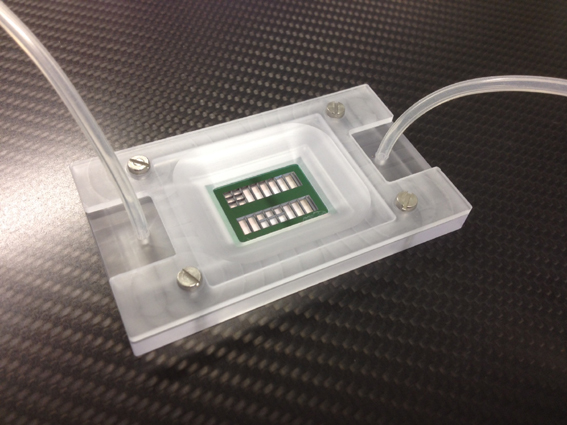
Description: Alongside diseases of the cardiovascular system, tumours are among the leading causes of death in Germany. The presence of tumour cells in peripheral blood and their quantitative changes over time are important indicators diagnosing a tumour, evaluating the success of tumour therapy and making a prognosis for the patient. The latest high-throughput methods of molecular biology, microscopy and molecular imaging allow anunprecedented breadth of analysis on a single-cell basis. However, these cells have to be isolated before further cell investigation is possible. The standard methods for qualitative and quantitative cell characterization include cell sorters with and without fluorescence activation. These methods do not provide satisfactory results for circulating tumour cells in blood. The overall objective of RamanCTC is to significantly improve identification and characterization of tumour cells circulating in the blood of cancer patients.
Contribution of IBMT: The Fraunhofer IBMT is exploring new microchips that allow high-throughput cell characterization. This is possible due to the precise and defined positioning of a very large number of cells, and thus their quasi-parallel investigation.
Funding: 13N12687 funded by BMBF
Funding period: 03/2013-02/2016
NANODETECTOR
Description: The main objective of the NANODETECTOR project is the development and validation of technologies for the detection and analysis of single nanoparticles in complex environments. The project is based on a new experimental phenomenon: single sub-wavelength objects give rise to optical signals in surface plasmon resonance microscopy. This provides a unique possibility forthe ultrasensitive on-line detection of nanoparticles. The technology will be implemented in a compact device, tested in different liquid and gas phases and applied for various practically relevant analytical tasks. The system can be used to monitor the safety of the environment during production and exploitation of nanoparticles and nanomaterials. Within the NANODETECTOR project, the new diagnosis method will be applied by producers of nanoparticles and nanoparticle-based materials. It will be used to monitor workplaces and waste material for exposure to nanoparticles. It will also be examined whether nanoparticle-based materials release nanoparticles over time. Another application scenario is the investigation of water and other transparent non-colloidal drinks (juices, white wine, etc.). More complex media will also be tested.
Contribution of IBMT: The Fraunhofer IBMT designs and develops sample delivery system, sensor cartridges and fluidic components for the prototype systems.
Funding: EU-FP7-NMP
Funding period: 06/2012-11/2015
d-LIVER

Description: Within the EU project "d-LIVER" the Fraunhofer Institute for Biomedical Engineering together with 13 European partners is developing an IT-based liver support system which permits medical observation of patients with chronic liver disease. The system can be used in the hospital as well as in a home environment. For the reliable application of the system for outpatients and in particular in a home environment it is essential to monitor the system and the patient during liver dialysis. To this end, new sensors and information and communication technologies will be developed. Within the "d-LIVER"-project, we will use bioreactors with living liver cells which, in contrast to purely technical adsorption or filtration techniques, can fufil the detoxification function, and, at the same time, the synthesis function of the liver. For this purpose, innovative technologies and sensors will be developed to facilitate large-scale cultivation of fully functional liver cells under controlled conditions.
Contribution of IBMT: The working group Microsensors & Microfluidics of the Fraunhofer IBMT develops new sensors to allow continuous monitoring of the quality and efficacy of the cells within the bio-artificial liver. Impedance spectroscopy is used as the main measurement principle. The sensors will be integrated into the bioreactor in cooperation with other partners. At the Fraunhofer IBMT, the tasks are carried out in cooperation with the working group In-vitro Culture Technologies. Furthermore, the working group Home Care & Telemedicine deals with all IT aspects of the liver support system.
Funding: EU-FP7-ICT
Funding period: 10/2011-09/2015
BIO-REEL
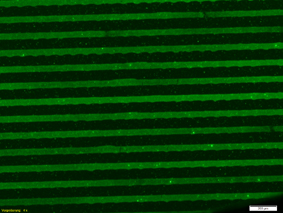
Description: The interdisciplinary research project BIO-REEL combines new findings from biotechnology and cell biology as well as production technology and microtechnology. The advantages of soft lithography (high lateral resolution) will be brought together with those of industrial printing processes to allow imprinting of large-scale substrates with high throughput speed. The project aims at designing highly efficient production equipment for the on-site immobilization of proteins on polymer foils in a rotative process. Targeted applications include mainly drug development, tissue engineering and stem cell research.
Contribution of IBMT: The Fraunhofer IBMT is responsible for the selection of the polymer foils, the design of microstructured printmasters, and the analysis of the immobilised protein layers.
Funding: BMBF ERANET 02PO2880
Funding period: 02/2010-01/2013
REMOTE
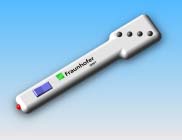
Description: The objective of REMOTE is to assist elderly people with health impairment in everyday life, so that they can maintain as much self-determination in their lives as possible. By means of information- and communication technology we will create a network comprising both social contacts and tele-health services. Among a multiplicity of commercial sensors, two sensors newly developed by the IBMT will be used. The new sensors detect the wetness of the oral cavity and the maxillary movements to infer eating and drinking habits. The complete network will be tested in selected locations in different places all over Europe.
Contribution of IBMT: The Fraunhofer IBMT is responsible for the development of miniaturised mouth-worn sensors for measuring the wetness of the oral cavity and the maxillary movements.
Funding: BMBF 16SV3831 und EU AAL-2008-1
Funding period: 04/2009-03/2012
Myoplant
Description: The objective of Myoplant is to realize a myoelectrically controlled, i.e. controlled by muscle signals, hand-/armprosthesis. For this purpose, we are developing an implantable device that can receive muscle signals directly and route them wirelessly to the actuated artificial hand. In spite of the augmented degree of freedom, the handling will be more intuitive and easier than with present models based on surface electrodes.
Contribution of IBMT: The department is responsible for the wireless communication between implant and hand prosthesis and the wireless energy supply of the device’s electronics by the external prosthesis.
Funding: BMBF 16SV3699
Funding period: 07/2008-06/2011
UlcPrevent
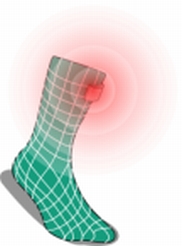
Description: The control of pressure load and pressure distribution of the affected body regions plays an important role in the treatment of diabetes and decubitus patients. With the aid of innovative microsensor developments implemented flexibly and individually in various textiles, ulceration in diabetics and wheelchair patients is to be reduced in a targeted and sustained manner by objective measurement of the pressure load on endangered parts of the body. This textile-based system will record and analyse pressure conditions of endangered body regions, indicating overload conditions to the patient, who will then be able to relieve the corresponding body part, e. g. toe, heel or pelvis.
Contribution of IBMT: The Fraunhofer IBMT is responsible for the wireless transmission of the measurement data from the textile (e. g. anti-decubitus sock) to an electronic evaluation device worn on the body. In addition to this, the IBMT is developing the evaluation electronics including the evaluation software.
Funding: 16SV3713 funded by BMBF
Funding period: 11/2008-04/2012
Replicator
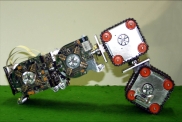
Description: Novel principles of adaptation for symbiotic multi-robot organisms are the main scientific interest in the REPLICATOR project. Such robot organisms consist of swarms of robots which can - if advantageous to do so - dock with each other and symbiotically share energy and computational resources within a single artificial life form. In order to be able to autonomously interact with each other and their environment, each individual robot module is equipped with a variety of sensors and actuators.
Contribution of IBMT: The department is responsible for on-board electronics, energy management and hardware integration.
Funding: EU FP7 ICT-216240
Funding period: 03/2008 – 02/2013
Rapid SPR for Parallel Detection of Pathogens in Blood (RaSP)
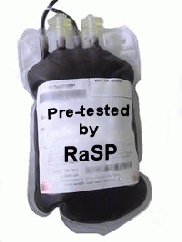
Description: RaSP is aimed at developing a very fast, cost-efficient and, at the same time, very sensitive method which has the potential to detect more than 100 blood pathogens simultaneously. RaSP aims at simultaneously detecting the pathogens HIV, hepatitis C, hepatitis B and syphilis to demonstrate the capabilities of the system. A simple and small desktop system which is easy to use and which leads to accurate results will be set up to allow the detection of the presence of any of the mentioned blood pathogens within 10-20 minutes. This would make it possible to exclude infected blood at an early stage from the blood banking procedure. RaSP exploits a new type of surface plasmon resonance (SPR) transducing principle that allows very fast and sensitive testing. The immunosensing diagnostic assay is based on the very specific immune reaction between antigens and antibodies.
Contribution of IBMT: TheFraunhofer IBMT is coordinating the project and is also responsible for the development of all micro-fluidic components.
Funding: EU SP5A-CT-2006-0445
Funding period: 01/2007-12/2009
Smart Integrated Biodiagnostic Systems for Healthcare (SmartHEALTH)
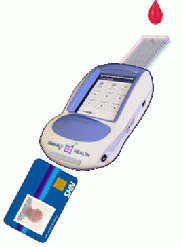
Description: SmartHEALTH will develop an open integrated architecture for new biodiagnostic systems to support European companies exploiting bioassays or new application concepts. The initial system has a disposable fluidic cartridge with a desktop base station linking to the ambient e-Health environment. This concept will be miniaturised and cost engineered to create a portable and more available product. It will perform multi-analyte sensing and interpretation, for nucleic acids and proteins, and will handle multiple biological sample types. Results will be interpreted and presented using bio-information analysis. Systems will be healthcare “user identity-” and “ambient environment” aware, respecting confidentiality and information access rights. Clinical areas for SmartHEALTH application are in Cancer Diagnostics - breast cancer recurrence monitoring, cervical cancer case finding, and colorectal cancer diagnostics, theranostics and prognostics.
Contribution of IBMT: The Fraunhofer IBMT is responsible for the packaging of biochips as well as for their integration in the lab-on-chip system. The working group “Homecare” of IBMT is in charge of all e-Health aspects of the project.
Funding: EU IST-NMP-2-016817
Funding period: 12/2005-11/2009
NanoEngineered Monolithic Optoelectronic transducers for highly sensitive and LAbel-free Biosensing (NEMOSLAB)

Description: The objective of this project is the development of silicon-based integrated optical biosensors capable of detecting single binding events as well as label-free biomolecular interactions. The transducer consists of several monolithicallly integrated silicon optocouplers interfaced with microfluidic channels directly on the silicon. The optocouplers consist of nano-engineered silicon light-emitting devices optically coupled to silicon nitride optical fibres and silicon detectors. The main project output is a monolithic silicon microphotonic biochip integrated with microfluidic channels and recognition biomolecules as well as the associated readout and control electronics assembled in a portable bioanalytical microsystem to be tested with specific panels of pituitary hormones, steroid hormones and DNA.
Contribution of IBMT: The Fraunhofer IBMT is responsible for the packaging of biochips as well as for the development of the fluidic, electrical and mechanical interfaces between lab-on-chip and read-out unit.
Funding: EU IST- 027804
Funding period: 01/2006-12/2008
Network of Excellence: Multi-Material Micro Manufacture (4M)
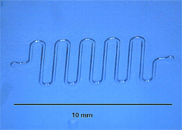
Description: The main aim of 4M is to develop micro and nano technology (MNT) for the batch-manufacture of micro-components and devices in a variety of materials. These processes, production equipment, and manufacturing platforms are to be incorporated into the factory of the future in a user-friendly manner. To achieve this, the Network seeks to integrate currently fragmented R&D capacity in non-silicon microtechnologies in the ERA into a European Centre of Excellence. The establishment of such an expert resource and infrastructure at the European level is designed to help European companies engaged in satisfying the growing demand for portable, wireless communication products and many lifestyle, health and transport-related systems incorporating MNT.
Contribution of IBMT: The Fraunhofer IBMT is leader of the task "biomedical platform" as well as deputy leader of the microfluidics division within 4M.
Web page: www.4m-association.org/interest-group/Micro-Fluidics-Interest-Group
Funding: EU NMP2-CT-2004-5002
Funding period: 10/2004-09/2008
Intelligent Small World Autonomous Robots for Micro-manipulation (I-SWARM)
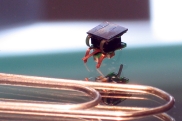
Description: This project aims to take a leap forward in robotics research by bringing together experts in the field of microrobotics in distributed and adaptive systems with experts in the field of self-organising biological swarm systems. The project aims at technological advances to facilitate the mass-production of microrobots, which can then be employed as a "real" swarm consisting of up to 1,000 robot clients. These clients will all be equipped with limited, pre-rational on-board intelligence. The swarm will consist of a huge number of heterogeneous robots, differing in the type of sensors, manipulators and computational power. Such a robot swarm can be used in a variety of applications, including microassembly, biological, medical or cleaning tasks.
Contribution of IBMT: The Fraunhofer IBMT is responsible for the wireless inter-robot communication as well as for the wireless powering of the micro-robots.
Funding: EU IST-VI 507006
Funding period: 01/2004-12/2007
Intelligent Intraoral Drug Delivery System (IntelliDrug)
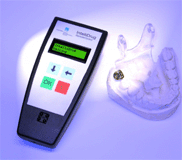
Description: Within the framework of the research project INTELLIDRUG, the Fraunhofer IBMT in collaboration with other partners is developing an intelligent medication system which – in contrast to invasive implanted drug delivery modules – can be placed in the oral cavity. The system offers an alternative for the treatment of addicts and chronically ill persons. In order to fix the drug system in the oral cavity, a (partial) dental prosthesis is needed. The size of the miniaturized system corresponds to the size of two back teeth. In addition to the actual drug delivery system placed in the oral cavity, there is also an external remote-control unit resembling a mobile phone. The intra-oral unit consists of a drug reservoir, a pump mechanism, a valve, sensors, control electronics, batteries and a protective housing.
Contribution of IBMT: The Fraunhofer IBMT is responsible for the development of the flow sensor, the drug level sensor, the electronics and the wireless communication.
Funding: EU IST-FP6 Contract No 002243
Funding period: 01/2004-12/2007
Intelligent micro-sensor, electro-actuated, stimulator of salivary glands (Saliwell)
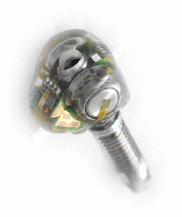
Description:
The Saliwell project was aimed at developing an effective, electrostimulation-based therapy for dry mouth without adverse side effects. This resulted in the design and production of a fully functional intelligent miniaturised prototype device with the size of a single tooth crown. The intelligent microsystem comprises an electrostimulator, a wetness sensor as well as batteries, electronics and a micro controller. The device can wirelessly communicate with an external remote control unit.
Contribution of IBMT: The Fraunhofer IBMT is responsible for the development of the electrostimulator, the wetness sensor and the wireless communication.
Funding: EU IST-2001-37409
Funding period: 07/2002-05/2005
Miniaturized Co-operative Robots advancing towards the Nano range (MiCRon)
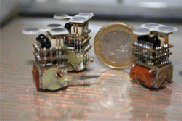
Description: The aim of the MiCRoN project was the development of a new microrobot system based on flexible, mobile, autonomous robots of just 1 cubic centimetre in size. As a result, several fully independent, completely independent working microrobots have been developed that can manipulate parts with a size of about 60 µm under a local, robot-based microscope. The robots can be equipped with several tools for micro and nano-handling as well as for biological cell-handling. The energy supply is realised with a power floor using magnetic fields, while the communication is based on infrared technology. The robot itself is currently one of the most highly integrated micro tools.
Contribution of IBMT: The Fraunhofer IBMT is responsible for the development of a micro-injection chip for cell injections, for the wireless power supply as well as for the wireless robot communication.
Funding: EU IST-2001-33567
Funding period: 03/2002-02/2005
A Bioanalytical Microsystem based on an Optical Microchip (BIOMIC)
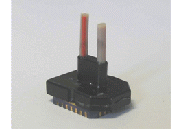
Description: The objective of the project is to develop a working prototype of a portable bioanalytical microsystem suitable for point-of-use biomedical, industrial and environmental testing. The microsystem is based on a monolithically integrated miniaturized silicon optical biosensor equipped with immunoaffinity and DNA recognition layers. The optical transducer consists of light sources, optical fibres and detectors monolithically integrated on a silicon chip through integrated circuit technology, and is capable of performing fast assays without the need of external optical components. The system also consists of the control and signal processing electronics, the appropriate packaging of the sensor, the microfluidic module and the basic analysis software.
Contribution of IBMT: The Fraunhofer IBMT is responsible for the packaging of the biochip as well as for the development of the fluidic, electrical and mechanical interfaces between the lab-on-chip and the read-out unit.
Funding: EU IST-2000-28214
Funding period: 06/2001-05/2004
Brain Shunt
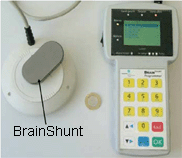
Description: Within the MOTIV project "Brain Shunt", the world's first and only active implant for the treatment of hydrocephalus diseases has been developed. It works as a binary switch, actuating the liquor drainage by means of a hard-coded opening frequency dependent on the time of day. By means of a special programming device, the hard-coded opening frequency can be changed non-invasively via an inductive interface. The therapy can thus be adapted individually to the patient’s requirements.
Contribution of IBMT: The Fraunhofer IBMT is responsible for the micro valve, the inductive energy supply, the wireless communication as well as for the entire electronic system and software.
Funding: supported by BMBF within the frame of “Kompetenzzentrum für Miniaturisierte Monitoring- und Interventionssysteme“ (MOTIV)
Funding period: 10/2000-12/2005

